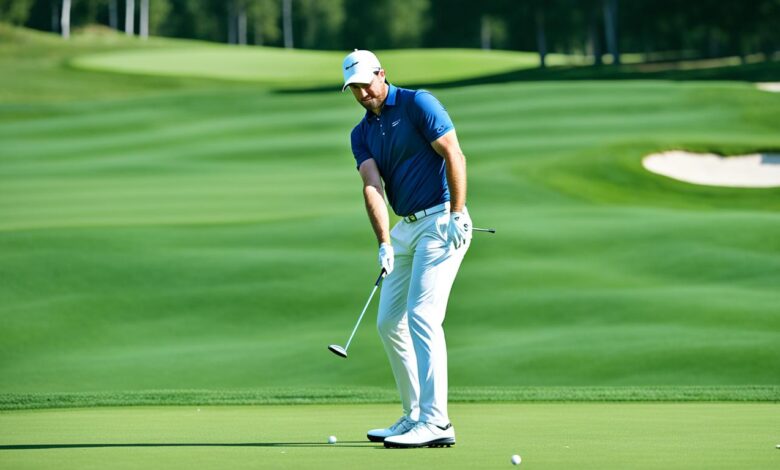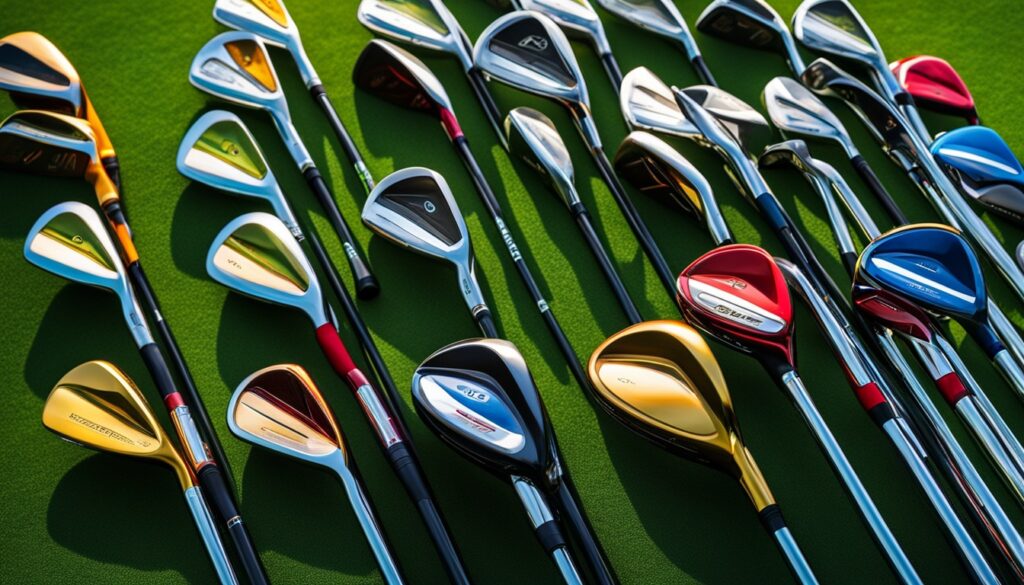Golf Basics Every New Player Should Know

Learning golf now is a smart move. You might have already seen how it fits perfectly in a world that values outdoor and distanced activities. It’s not just a sport. Golf offers exercise, an escape, and fun challenges.1
Yet, golf can seem tough to get into. The game, gear, and rules can be overwhelming for newbies. But, don’t be discouraged. Everyone starts at the beginning, and mistakes are part of the learning process.
We’re here to help you start on the right path. Here, you learn the essentials. Not just how to swing a club, but also what club to use and other must-knows. Plus, you don’t need fancy gear like golf shoes from day one.1
Golf Digest, a leading guide on the sport, has been popular for 70 years. This shows there’s a lot to discover about golf. However, it’s best to focus on the basic tips now. When you are, we’ll be here to guide you further.
Key Takeaways
- Golf Digest has been providing golf information for 70 years1
- GolfTEC has analyzed swing data on over 50,000 players1
- Starting golf can cost less than $500 with strategic equipment purchases1
- A maximum of 6 clubs are needed to effectively start playing golf1
- Box sets of golf clubs can be found for less than $2001
Introduction: Conquering the Intimidating Elements of Golf
Golf is perfect for today’s world—it’s played outside across large areas, promotes good physical activity, and keeps our minds busy.2 But, there are things that might scare you off, like how tough the game is, all the gear you need, and the many customs to learn.3
Golf: A Game for Social Distancing
In these times, golf’s giant open spaces and the need to stay apart keep players safe.2 It’s a chance to breathe fresh air, move your body, and challenge yourself in a fun way.
Don’t Sweat the Complexities
Even pros started out struggling, and many are still learning along the way.2 We aim to show you the simple stuff: how to hit a ball, what you need for it, and more to start well (by the way, you can do without special shoes at first).3
Golf Digest’s Role in Teaching Basics
Golf Digest has lasted 70 years for a good reason. It’s full of insights on the fantastic game of golf. But for now, let’s stick to the easy parts. When you’re eager for more, we’ll be here to help.
Instruction: The How-To-Play Essentials
Johnny Miller, a golf great, shared a funny story about teaching golf to his kids.1 He first let them hit golf balls into a pond to see the splash. Later on, they learned more about holding a club and swinging it right. Miller showed that having fun and learning the basics can go together. Getting lessons from a good coach can help you a lot. Eventually, you might find those technical tips useful. Golf teacher Will Robins supports this approach. He says, start with the joy of playing. The details come later.
Should You Take Lessons or Learn Independently?
Learning starts at places like a practice range or Par-3 course, not just in theory.4 Start with the fun of playing. This could be in an open field with some plastic balls. Before diving deep, get used to moving the club smoothly around you.
Embracing the Dynamics of the Game First
Robins talks about two phases of learning in golf. In the first, it’s all about having fun and feeling the swing.1 But when you focus too much on technique, you might mess up. Stay relaxed and swing the club smoothly. The goal isn’t hitting the ball hard but feeling a good, balanced finish.
Focusing on Swing Motion and Balanced Finish
Robins’ video series is great for new players. It teaches with fewer overwhelming swing ideas. Instead, it focuses on how to move and finish your swing smoothly.1
What Are the Basics for Hitting the Ball Solid?
Want to hit the ball well in golf? Start by learning what the best players do. Nick Clearwater, from Golf Digest, teaches us. He says many new golfers make a common mistake.
They turn their shoulders flat, like they’re looking back to talk to someone. Yet, pros do it differently. They tilt their shoulders. This means the shoulder nearer to the target is lower than the other when they turn. This simple tweak can help hit the ball more solidly.1
Shoulder Turn and Tilt
Newbies often forget to fully turn their hips towards the target as they swing down. Instead, they rely too much on their hands and arms. But professionals show their hips facing the target at impact. They turn their hips much more, almost double.
Hip Rotation and Its Impact
Improving to pro-level moves from players without copying a single swing can benefit beginners. Clearwater has analyzed over 50,000 players. From this, he found the most important things all successful swings have. Knowing these can make your hits more solid.1
Benchmarks from Tour Players’ Swings
By learning and applying these basic swing principles, new golfers can improve their hits. They can start hitting the ball solidly and more often.
Understanding When and How to Use Different Clubs
Every club has a special job. It’s aimed at sending the ball a set distance and path. The longest clubs like drivers hit the ball far and low.5 Smaller clubs, though, like a sand wedge, make the ball go shorter and come down steeply.
Club Design and Intended Purpose
To use each club well, it’s crucial to set up right. For instance, with a wedge, aim for clean contact and hit the descending ball. So, it should be slightly behind your front foot. But with a driver, set the ball up near your front foot.
Ball Position and Club Set-Up
Golf Digest’s Cameron McCormick teaches how to use your clubs effectively. His video series acts like an owner’s manual, especially for beginners.
Mastering Club-Specific Techniques
Today, pros prefer drivers with more loft, around 10-11 degrees. In the late 1990s, 7 degrees was common on the PGA Tour. Now, golfers also use higher lofted woods over the 2 and 4 woods.
Hybrids have become more popular, replacing the hard-to-hit 3 and 4 irons. Wedges come in different lofts for different shots. Putters are for the final hits on the green, and there are many putter types available.6 Golfers carry a mix of clubs in their bags to handle various golf situations.6

Equipment: Everything You Should Know About What to Play
The Bare Minimum: Essential Clubs and Gear
You’ll need a driver for those long shots on par 4s and par 5s. Including, fairway woods or hybrids for distant shots. A sand wedge can help you around the green, and a putter for the final touch. Also, don’t forget your golf balls, golf bag, tees, a divot tool, and a towel. This basic set can get you started for under $500.1
Cost-Effective Strategies for Beginners
Full club sets are great for starting, then you cut down to essentials. You can get decent box sets for under $200. Or find quality used clubs on sites like GlobalGolf.com. Tip: Spend under $25 for golf balls until you get better and stop losing them.1
Upgrading Your Equipment: The Next Step
If you’re ready for a stronger commitment, think about a custom-fitted new driver. You can get a quick fitting at your local golf shop or online with some companies. This will help you choose a driver that counters your slice.4 For newbies, adjustable drivers with movable parts can be a big help. They correct slices by adjusting the face.
The Importance of Custom Fitting
For new or occasional golfers, a driver designed to hit ‘draws’ can be very helpful. You might need a bit more loft, like 10.5 degrees, at first. Luckily, today’s drivers let you tweak the settings by up to two degrees to match your improving skills.
Driver Fitting and Slice Correction
Finding a driver that combats your slice is key. Many drivers can be fine-tuned to help, thanks to adjustable parts. These parts can turn the ball’s flight from a slice into a straighter or controlled fade.
Adjusting Loft and Settings
Discovering the right driver might be simpler than you think. Aim for one that fixes your slice problem. With the right adjustments, you can make the ball fly straighter or with a controlled fade.
Golf Basics Every New Player Should Know
Mastering Fundamentals: Posture, Grip, and Stance
Spotting a skilled golfer is easy even before they swing. They focus on three key basics: posture, grip, and stance. These fundamentals are done in a specific order, known as a pre-shot routine, to ensure consistent performance.
7 First, correctly grip the golf club with your hands. Then, position yourself near the golf ball with one leg forward and bend at the hips. Lastly, adjust your foot positioning until you feel well-balanced.
Understanding Ball Flight and Hitting Techniques
For new players to lift the ball, they must learn to hit the ground the right way.7 Stand in a good posture and imagine you’re extending your arms towards the ground, similar to throwing a ball. It’s okay to tap the ground lightly when practicing.
Knowing Your Club Distances
Even if you’re just starting, it helps to know how far your clubs can reach.7 Keep track of shot distances when you hit them well, whether using an app, rangefinder, or walking it off. These numbers will improve over time, aiding in your game’s consistency.
Developing a Reliable Fairway Club
When you first hit your ball onto the fairway, having a favorite golf club is key for many.7 It’s all about choosing a club that feels right and helps you hit good shots. For many, a 7-wood can be that perfect fairway club. It travels far but is still easy to use.7
Finding a fairway club you trust is a game-changer for beginners.7 Trying out various fairway woods and hybrids helps. This step is vital to improving your fairway play and having more fun on the golf course.7
Mastering the Basic Chip Shot
Starting out, hitting a basic8 chip shot is key. For this, grip the club lower, stand a bit narrower, and tilt towards your target. Then, using a basic putting motion, brush the grass. A pitching wedge works well for this, start practicing with it.
Technique and Club Selection
Choosing the right club for the8 chip shot matters a lot. Go for clubs with a lot of loft, like sand or lob wedges, for better control.8 Trying out different clubs helps you learn about loft and its effects on the ball’s path and roll. This way, you refine your chipping style.
Before you chip, imagine how you want the ball to land. This can boost your accuracy.8Avoid key mistakes such as hitting the ground before the ball, swinging too hard, and not practicing enough. A smooth, not too hard swing keeps your shots steady.
Keep at it with regular practice,8 placing targets on the green, and changing up distances and lies. These are crucial for a consistent chipping form.8 With patience and the right approach, new players can nail down the chip shot basics and upgrade their8 short game.
Short Game Priority Order
Remember, the smaller the move, the lower the chance of error in golf. So, focus on the short game first. Always try to putt first. If that’s not possible, use the chip shot. And if you must hit the ball further with less loft, then pitch. This strategy helps to keep the ball in play even after a missed shot. It teaches you to choose wisely and manage the game’s risks, crucial for new golfers.
Putting, Chipping, and Pitching
9 Almost two-thirds of golf shots are from less than 100 yards, with putting being the main skill, covering 43% of these shots.9 Pros hit the green 12-14 times in a round, but for amateurs, hitting fewer greens, chipping and pitching are key lifesavers. A well-placed pitch or chip can save a lot of strokes, especially close to the green. This is because these shots focus on more roll and less airtime. But players often find pitch shots tough because they require a delicate touch and not a full swing.
Risk Management on the Course
7New golfers often start with putting as their go-to skill, while 42% pick chipping first.10 Knowing the importance of each short game shot is vital. Always aim to putt first, then chip, and pitch as a last resort. This strategy keeps the ball closer to the target, even if the first choice shot doesn’t go as planned. It’s a smart way for beginners to learn risk management on the golf course.
Bunker Shot Basics
Sand shots are tough for new golfers. The trick is not to try to lift the ball. Aim to hit the sand first.11 Many golfers, especially beginners and those with higher handicaps, find bunker shots hard.11 This is because they need a different approach than other shots.
Committing to Hitting the Sand
Getting the ball out of a bunker means hitting the ground first.12 It’s easy to make mistakes like having stiff wrists or hitting down too hard. This happens when you don’t practice bunker shots.
The right way includes having an open stance and loose wrists. This helps the clubface get under the ball.
Proper Stance and Ball Position
Get a good footing in the sand. Put the ball a bit ahead in your stance.11 Doing a lot of work before you hit the shot is crucial. This includes 6 important steps for your technique.11 Many golfers struggle because they move too much. So, focus on hitting the sand first.
Improve your bunker shot to save strokes on the course.12 Use a 56-degree sand wedge for better results. This method has a success rate of about 60%12. Shift your weight onto your lead leg and use a special hand grip, especially if you’re right-handed.11

Essential Equipment for Beginners
Starting out in golf requires a few key items. You need the basics to enjoy the game. The cost of clubs, bags, and gear adds up fast. Beginners can start with a few key things.
Golf Balls and Tees
A good start for golf balls is to carry 9 during your game. This ensures you’re ready if some go missing.13 Pick two-piece golf balls. They are strong and help with distance.
Being a beginner, carry about 10 tees for each round.13
Divot Tool and Towel
Along with balls and tees, a divot repair tool and towel are essential. A divot tool fixes marks on the course. This keeps it in good shape for others. A towel helps keep clubs and hands dry.14
These items help with golf course manners and keep you comfortable as you play.
These basics set you off on a good start in golf. Focus now on improving your game. Later, add more clubs and gear for a better experience.
FAQ
What are the basics for hitting the ball solid?
How do I understand when and how to use different golf clubs?
What are the essential golf equipment pieces for beginners?
How can I upgrade my golf equipment as a beginner?
What are the fundamental golf basics every new player should know?
How can I develop a reliable fairway club as a beginner?
What is the proper technique for the basic chip shot?
What is the short game priority order for beginners?
How do I properly execute a bunker shot as a beginner?
Source Links
- https://www.golfdigest.com/story/the-complete-beginner-s-guide-to-golf
- https://medium.com/@upt_ai_golf/a-beginners-guide-to-essential-golf-terms-ac13ee07b02d
- https://elitegolfofaz.com/a-beginners-guide-to-starting-adult-golf-lessons-in-arizona/
- https://www.thediygolfer.com/blog/golf-for-beginners
- https://columbiaassociation.org/golf/think-like-the-pros-when-to-use-different-golf-clubs/
- https://www.pinemeadowgolf.com/golf-clubs-101/1-basics
- https://golf.com/instruction/golf-basics-every-beginner-golfer-should-know/
- https://deercreekflorida.com/2023/how-to-hit-a-chip-shot-in-golf.html
- https://danbubanygolf.com/mechanics-of-the-short-game/
- https://lastheplace.com/2022/05/17/everything-you-need-to-know-about-playing-golf-beginners-guide/
- https://www.golfdigest.com/story/hot-to-hit-a-bunker-shot-golf-simple
- https://www.golfsidekick.com/knowledge/how-to-play-bunker-shots/
- https://www.performancegolf.com/blog/golf-essentials-every-beginner-should-have-in-their-bag
- https://golftripjunkie.com/news/basic-golf-equipment-for-beginners

